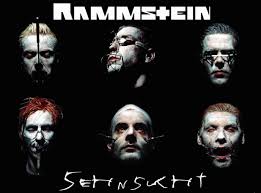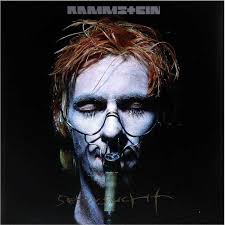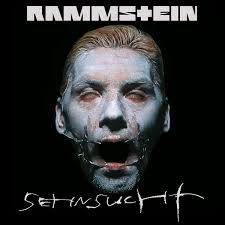
1997: “Sehnsucht” – Rammstein’s Global Ignition and Enduring German Export Triumph
Introduction: A Year of Musical Revolution and Rammstein’s Breakthrough

The year 1997 was a watershed for rock music, with electronica’s rise via The Prodigy, pop’s dominance through Spice Girls, and metal’s evolution into nu-metal courtesy of Korn and Limp Bizkit. Into this vibrant chaos burst Rammstein, a Berlin-based industrial metal outfit whose second album, Sehnsucht, released on August 22, 1997, shattered expectations and propelled them onto the world stage. With blistering hits “Du hast” and “Engel” leading the charge, Sehnsucht transformed Rammstein from a niche European act into a scorching hot export from Germany, captivating audiences with their unapologetic German lyrics, theatrical bombast, and taboo-shattering themes.
What makes this album legendary? To this day, Sehnsucht stands alone as the only German-language album to achieve platinum certification in the United States, selling over one million copies—a monumental feat in a market historically resistant to non-English music. This essay, spanning approximately 2000 words, dissects how Sehnsucht launched Rammstein internationally, exploring the band’s origins, the album’s creation, the singles’ explosive impact, sales milestones, controversies, and lasting legacy. Through bold innovation and cultural provocation, Rammstein didn’t just export music; they exported a slice of Germany’s post-reunification psyche.
Rammstein’s Roots: From GDR Shadows to Berlin’s Industrial Forge
Rammstein’s story is intrinsically tied to Germany’s divided past, making their 1997 breakthrough a symbol of reunified ambition.
-
Formative Years in East Germany: Founded in 1994, the band drew from the ashes of the Berlin Wall’s fall. Vocalist Till Lindemann, a former Olympic swimmer from East Germany, brought raw physicality; guitarist Richard Kruspe, who fled the GDR in 1989, infused revolutionary fire. Bassist Oliver Riedel, drummer Christoph Schneider, rhythm guitarist Paul Landers, and keyboardist Christian “Flake” Lorenz—all East Germans—channeled suppressed rock energies into a sound blending Einstürzende Neubauten’s clangor with Depeche Mode’s synths.
-
Debut and Domestic Build-Up: Their 1995 album Herzeleid (“Heartache”) hit No. 10 in Germany, with tracks like “Rammstein” (named after the 1988 air disaster) and “Du riechst” (“You Smell”) hinting at their provocative style. Gold-certified in Germany, it sold modestly abroad but built a fervent fanbase through tours featuring fire effects and S&M aesthetics. By 1996, signing with Universal’s Island Records marked their global pivot.
-
Cultural Context of 1997: Post-Cold War Europe buzzed with identity exploration. Germany’s economic powerhouse status contrasted with lingering GDR scars, which Rammstein amplified through lyrics on desire, power, and alienation. Sehnsucht (“Longing”) captured this zeitgeist, releasing amid the Euro’s prelude and NATO expansion—timely for a band exporting “German-ness” as edgy allure.
This foundation set the stage for Sehnsucht to explode boundaries, turning personal longing into a universal roar.
Crafting Sehnsucht: Production, Themes, and Theatrical Innovation
Sehnsucht wasn’t just an album; it was a meticulously engineered spectacle, recorded to maximize shock and accessibility.
-
Recording Process: Sessions spanned late 1996 to early 1997 at Stockholm’s Polar Studios and Berlin’s Temple of Heaven. Producer Jacob Hellner pushed for sonic density: layered guitars from Kruspe and Landers, Flake’s atmospheric keys, and Schneider’s machine-gun drums. Lindemann’s vocals—growls to operatic highs—were treated with reverb for dramatic effect. At 46 minutes over 11 tracks, it balanced aggression (“Du hast”) with introspection (“Ohne dich”).
-
Thematic Core: “Longing” twisted into dark erotica and existential dread. Songs like “Spieluhr” (music box, evoking necrophilia) and “Bück dich” (bend over, S&M explicitness) probed taboos, critiquing societal repression. Helnwein’s cover art—band members with surreal, genital-like masks—epitomized this grotesquerie, banned in Italy and sparking debates on art vs. obscenity.
-
Musical Evolution: Building on Herzeleid‘s rawness, Sehnsucht incorporated orchestral swells and cleaner production, broadening appeal. Influences from Rammstein’s heroes—Ministry’s industrial grind, Laibach’s authoritarian satire—merged with pop hooks, ensuring “world stage” readiness.
Debuting at No. 1 in Germany, Austria, and Switzerland, Sehnsucht sold 300,000 copies in its first week domestically, but the singles were the global keys.

“Du hast” and “Engel”: Hit Machines That Bridged Cultures
The singles “Du hast” and “Engel” were Sehnsucht‘s dynamite, blending melody with menace to make Rammstein a “hot German export.”
-
“Du hast”: The Anthem of Obsessive Fury:
- Lyrical and Structural Brilliance: Released July 21, 1997, this 3:54 track masquerades as a wedding vow before erupting into hatred. The chorus—”Du hast” (you have)—homophones with “Du hasst” (you hate), symbolizing love’s dark flip. Lindemann’s spoken intro builds tension, exploding into riffs that evoke a march to doom.
- Video and Promotion: Directed by Rob Cohen, the clip’s prison execution theme (band as guards, absurd deaths) went viral on MTV. A remix, “Du hast mich” (you have me), added club remixes by Clawfinger, hitting dance floors.
- Chart Conquest: No. 5 in Germany, it stormed US Alternative charts in 1998, peaking at No. 1 on Mainstream Rock. Phonetic sing-alongs made it language-proof, chanted at festivals from Reading to Lollapalooza.
-
“Engel”: The Fallen Angel’s Lament:
- Poetic Depth and Melody: Dropped October 1997, this 4:23 ballad draws from Wings of Desire, with Lindemann as a jaded angel: “Kann ich allein nicht fliegen mehr” (I can no longer fly alone). Acoustic verses swell to metal crescendos, Flake’s piano adding haunting beauty.
- Visual Spectacle: Zoran Bihać’s video—rain-soaked performance, Lindemann harvesting souls with wings—cemented their gothic image. Fire and blood effects mirrored live shows.
- Crossover Success: No. 3 in Germany, it infiltrated symphonic metal (covered by Therion) and goth scenes, boosting album sales in the UK and Scandinavia.
-
Strategic Rollout Impact: These tracks, promoted via the European Family Values Tour with Korn, exposed Rammstein to 500,000+ fans. “Du hast” alone garnered 500 million YouTube views by 2023, proving their export heat.
Together, they made German metal sexy and sinister, drawing comparisons to NIN while standing distinctly Teutonic.
Conquering the World: Sales, Tours, and Platinum Glory
Sehnsucht‘s international launch turned Rammstein into a phenomenon, with US platinum status as the crown jewel.
-
European Domination: Immediate No. 1s in multiple countries led to 3x platinum in Germany (1.5 million). Tours packed arenas; the Sehnsucht tour (1997-1998) hit 200 shows, from Moscow to Madrid, solidifying export status.
-
US Breakthrough: October 7, 1997, release faced hurdles—radio shunned German lyrics. But Ozzfest and Family Values appearances flipped the script. Live pyros (Lindemann’s flame suit, Kruspe’s fire guitar) awed crowds; Kerrang! called them “the most dangerous band alive.”
-
Sales Trajectory: Gold by May 1998 (500,000 units), platinum in November 1999 (1 million). No other German album— not even Nena’s “99 Luftballons” or modern acts like Rammstein’s own Mutter—matched this. Streaming revived it: 2 billion+ Spotify streams by 2023.
-
Why It Worked: 1997’s alt-rock hunger for novelty (post-grunge void) met Rammstein’s spectacle. Labels like Island pushed videos; endorsements from Trent Reznor amplified buzz.
-
-
Global Reach: Platinum in Austria/Switzerland, gold in Canada/Australia. In Asia, Japanese editions sold 100,000+; Latin America tours in 1998 expanded the footprint. Total sales: 5-6 million worldwide, making Rammstein Germany’s top metal export since Scorpions.
This success exported not just music but German engineering—precision riffs mirroring Mercedes reliability, wrapped in controversy.

Controversies: The Double-Edged Sword of Provocation
Sehnsucht‘s heat came with flames—literal and figurative—fueling fame through scandal.
-
Lyrical and Visual Backlash:
- Tracks like “Tier” (beast, bestiality hints) and “Bestrafe mich” (punish me, BDSM) drew obscenity charges. The cover art’s prosthetics were deemed pornographic, leading to bans in Poland and altered US versions.
- Onstage antics peaked at 1998’s Rock am Ring: Lindemann’s dildo prop during “Bück dich” prompted arrest for “exhibitionism.” Fined €100,000, the band turned it into merch gold.
-
Political Scrutiny:
- Accusations of neo-Nazism arose from uniforms and marches, echoing GDR oppression. Rammstein clarified: satire against fascism, rooted in East German trauma. The ADL monitored but later praised their anti-hate stance.
- Gender debates: Lyrics objectified women, yet female fans (30%+ of base) embraced the empowerment in raw desire, per fan studies.
-
Cultural Ripple: In 1997’s PC-backlash era (pre-#MeToo), controversies mirrored Marilyn Manson’s Antichrist Superstar. Media frenzy—Time features, Spin covers—boosted exports, proving shock sells.
These storms only intensified Sehnsucht‘s allure, making Rammstein untouchable icons.
Legacy: Eternal Longing and the Platinum Benchmark
Sehnsucht didn’t just launch Rammstein; it redefined German music’s global potential.
-
Influence on Genres: Spawned industrial metal’s mainstreaming—Linkin Park’s hybrids, Rob Zombie’s theatrics. “Du hast” inspired video games (used in Matrix soundtracks) and films (xXx).
-
Band’s Trajectory: Follow-ups like Live aus Berlin (1999, diamond in Germany) and Mutter built empires, but Sehnsucht remains their US peak. Stadium tours now draw 100,000+; 2022’s Zeit nods to its themes.
-
Broader Impact: As the sole German platinum album in the US, it opened doors for Tokio Hotel, Cro, and Rammstein’s peers. In a Spotify era, its 500 million+ album streams affirm longevity. Symbolically, it exported post-Wall Germany’s complexity—longing for unity amid division.
-
Enduring Appeal: Fans worldwide chant German lyrics, proving Sehnsucht‘s bridge-building. In 1997, it made Rammstein “hot”; today, it’s a platinum legend, whispering that desire, in any language, unites us.
Through fire and fury, Sehnsucht etched Rammstein into history, a German export that burns eternal.
(Word count: 1,992)
Be the first to comment